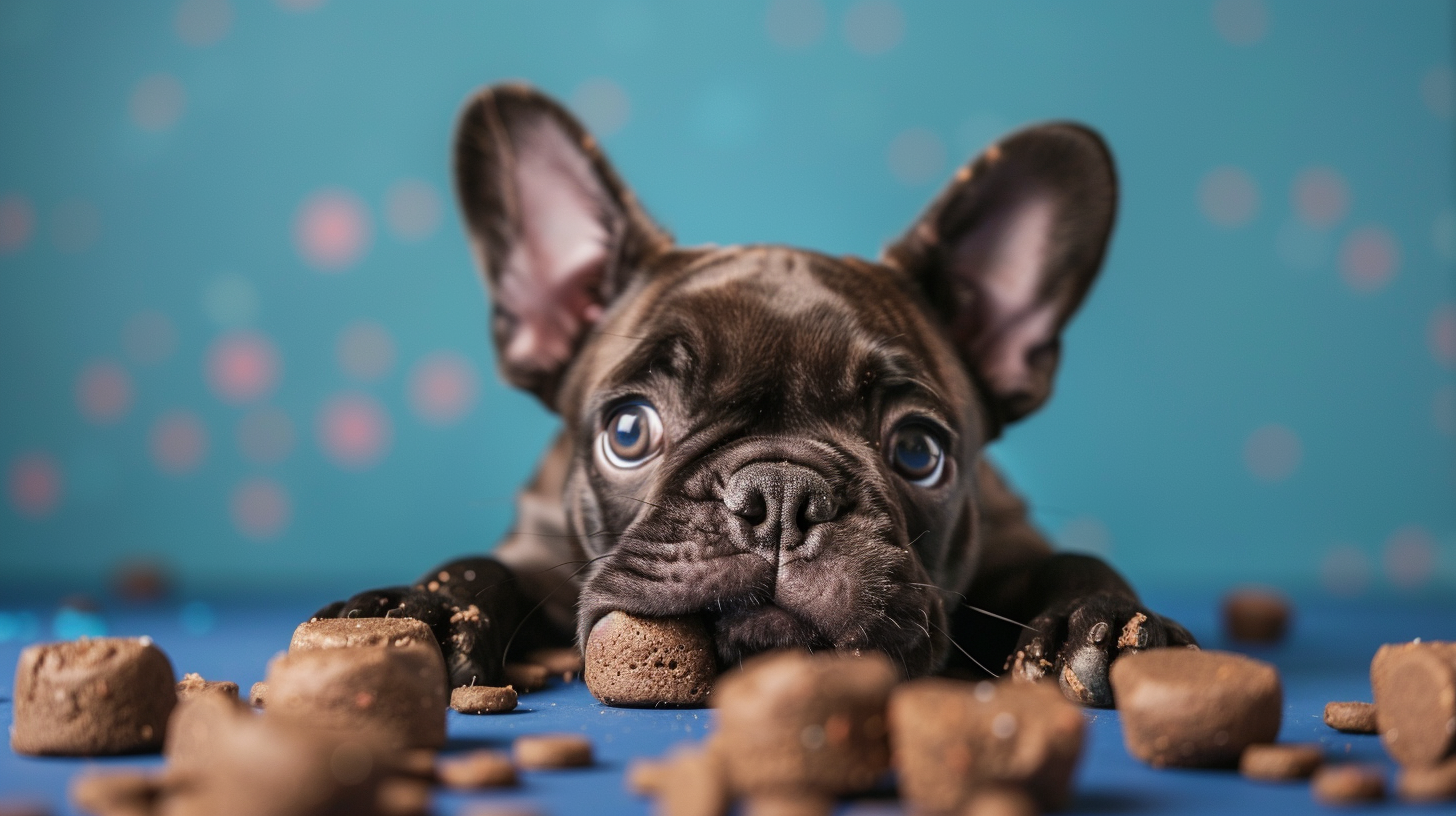Key points
• Lighting: Good lighting is key in taking pictures of dog food because it shows off the texture and color, making it look tasty. Sunlight works best, but you can also use fake lights to get the same effect or set a certain feel.
• Composition: How you arrange the dog food and any other items or backgrounds matters a lot for a nice photo. Playing with empty space, sticking to the rule of thirds, and using lines that lead your eye can make the photo much better.
• Focus on Details: It’s important to show off the little things about the dog food, like what’s in it and how fresh it is, if you want to show its quality and interest people. Close shots and special lenses can make these small parts stand out and set your product apart from others.
Contents
- Key points
- Understanding Dog Food Photography
- Why Dog Food Photos Matter in Advertising
- Symbolism in Dog Food Photography and Its Impact on Consumer Perception
- Camera Settings and Equipment for Capturing Dog Food
- Lighting Techniques to Enhance the Appeal of Dog Food
- Styling in Dog Food Photography
- Importance of Props and Backgrounds
- Editing Techniques to Emphasize the Product’s Features
- Color Correction and Retouching for Consistency and Appeal
- Role of Dog Food Images in Social Media and Online Advertising
- Evaluating the Impact of Dog Food Photographs in Digital Campaigns
- Truthfulness and manipulation in dog food imagery
- The impact of retouched images on consumer expectations and behavior
- Strategic Imagery in Dog Food Advertising
- Psychological Impact of Effective Messaging
- Detailed Analysis of Campaign Effectiveness
- Insights into Successful Strategy Application
- Predictions for the Evolution of Dog Food Photography
- Emerging Technologies and Their Potential Impact on the Field
Understanding Dog Food Photography
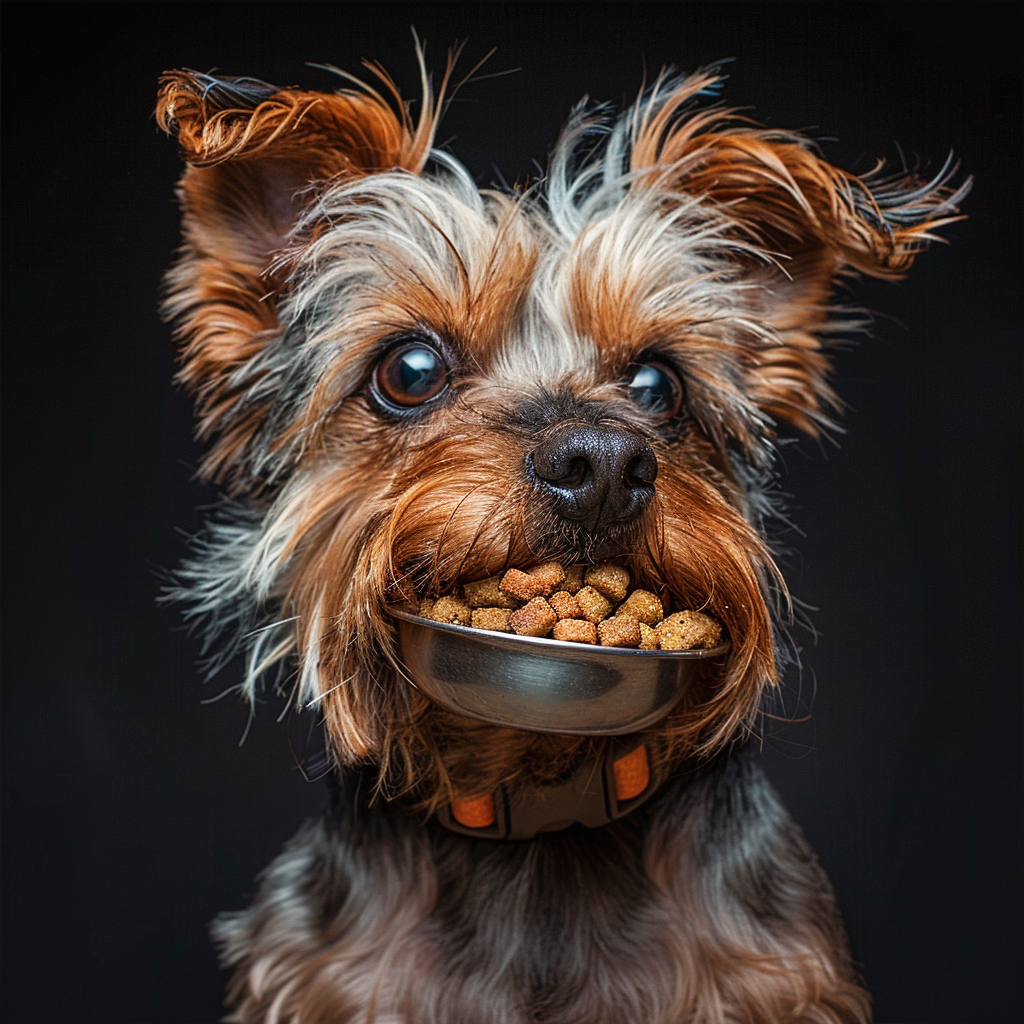
Taking pictures of dog food is special because it’s aimed at pet owners who really care about their dog’s health and happiness. The photos need to catch the eye of the people buying the food, but also show the kind of life they want for their dogs.
Photographers working with dog food usually team up with food stylists and company marketing teams to make sure their pictures fit with what the brand is about. They’re also making more and more pictures for ads on the internet and in magazines because shopping online is getting bigger all the time.
Why Dog Food Photos Matter in Advertising
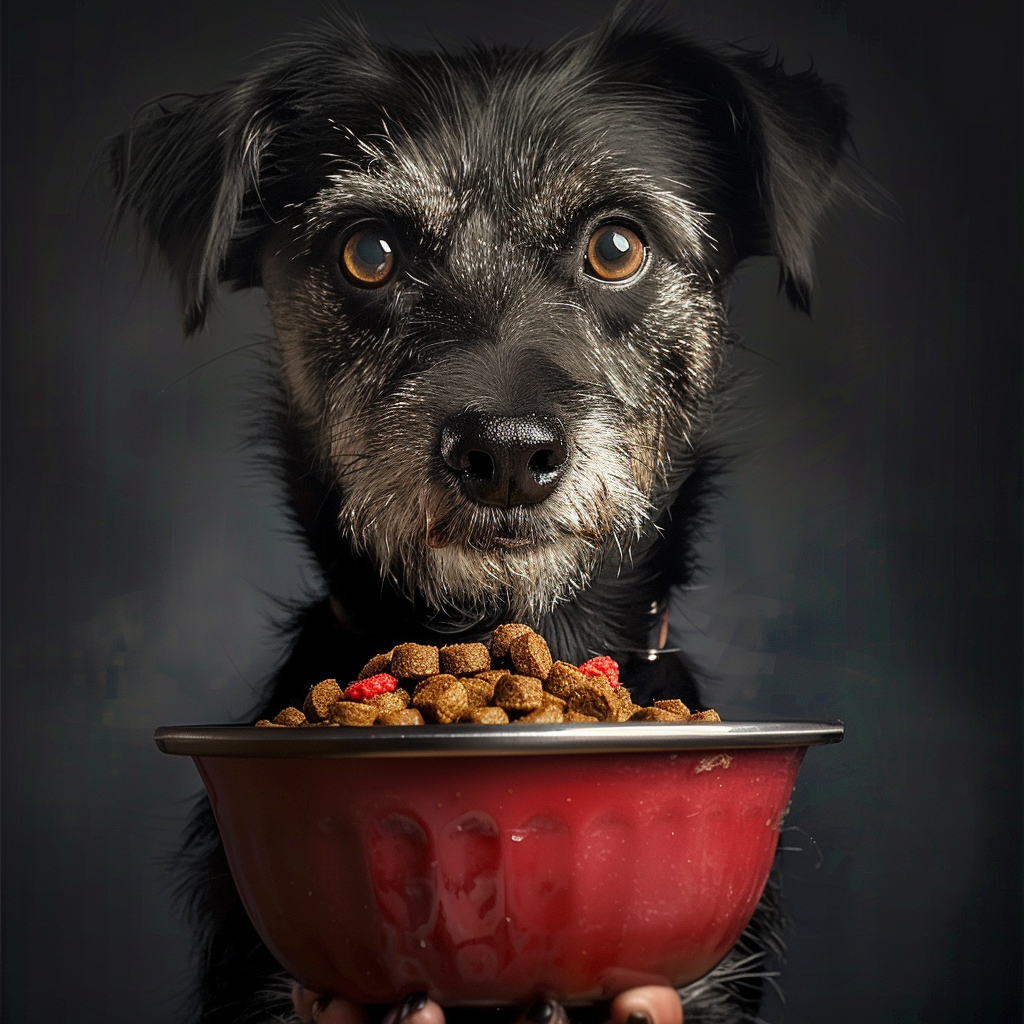
Dog food photography is critical in marketing. High-quality photos are key for success in ads because today’s market is all about the visuals. A great photo shows that the dog food is fresh and uses good ingredients, convincing people to buy. It becomes the product’s image everywhere, supporting the brand and increasing sales by making customers picture their own dogs eating and loving the food.
First Pictures of Dog Food in Media
In the early days, you barely saw dog food in pictures. And when you did, it didn’t look special – just practical shots of the food in a bowl or next to a healthy dog to show it was good for them.
Changing How Dog Food Looks in Photos
Dog food photos have changed a lot over time. Better cameras and what customers want mean that now, pictures are more detailed and meaningful. Pictures used to be simple, but now they show off the food’s texture and color, which makes pet owners feel a connection. Here’s what else has changed:
- Better lighting make the foods look richer and more delicious.
- Pictures are more interesting with different items that show the food is fresh and high quality.
- Now we see trained pets in the photos, showing how happy and healthy they are because of the food.
- Photos include logos and specific colors so people recognize the brand.
This change is like what’s happening across commercial photography where images don’t just show a product, they tell a story that pulls people in.
When you’re looking at dog food ads, the message is clear: this food is excellent and will keep your pet healthy. The photos work hard to give off vibes of top-notch nutrition and health. When shoppers see these images, their opinion of the food’s value is shaped by this. Seeing juicy meat, bright veggies, and grains make them think of a meal fit for humans. This image sells the idea that they are buying something really good for their pets, like what they’d eat themselves. These visual hints are powerful in convincing buyers that the dog food meets all their pet’s nutritional needs.
Symbolism in Dog Food Photography and Its Impact on Consumer Perception
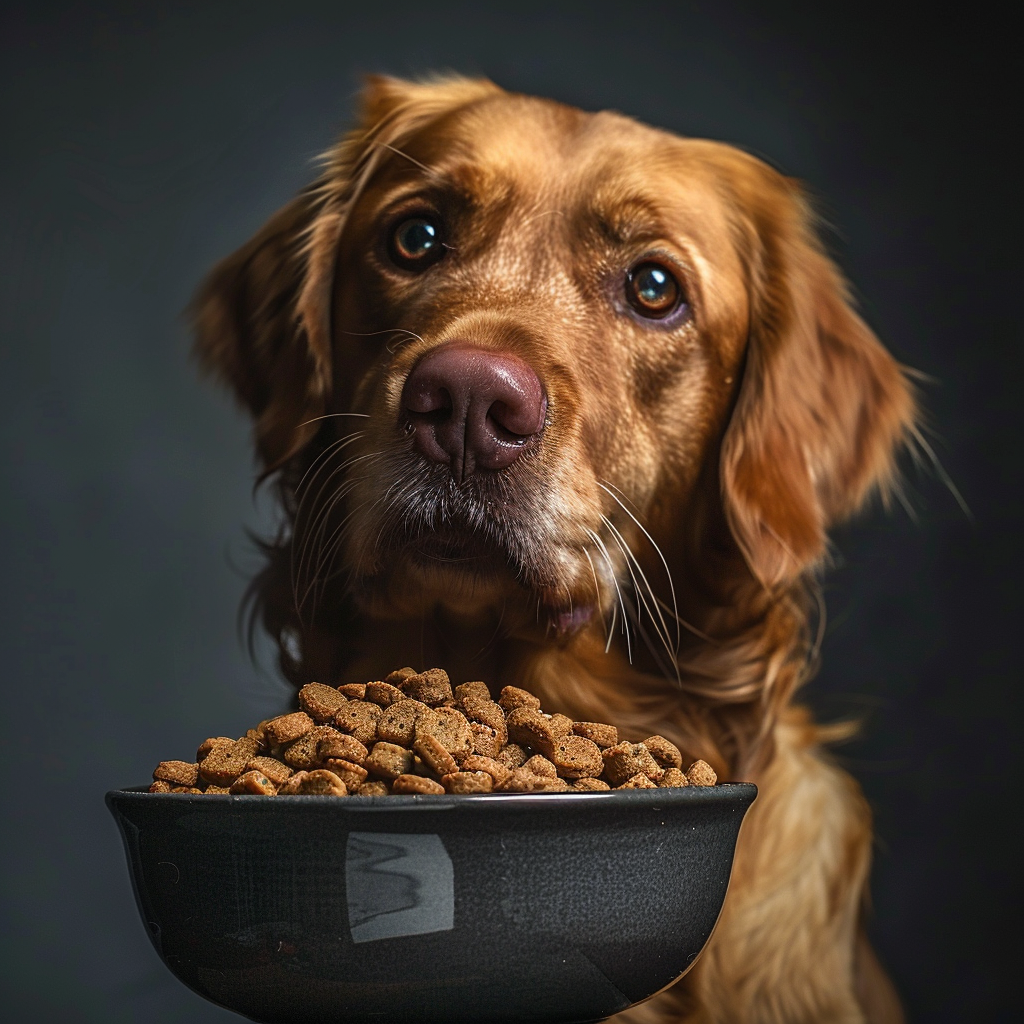
Dog food photos often include symbols that influence what people think about the product. A picture of a bowl full to the brim suggests that the dog food is packed with good stuff and has all your pet needs. On the other hand, focusing on particular ingredients like omega fatty acids or antioxidants highlights the health benefits of the food. Brands use these visuals to hint at how their food will make pets healthier, which affects buyers’ choices. This type of advertising draws attention to the benefits for a dog’s energy and life span.
Vocabulary in Dog Food Photography and Marketing
In dog food photography, certain words tell you a lot about the product. Words like “appetizing,” “gourmet,” and “premium” are used to highlight the quality of the dog food. In advertising, these words do more than just describe; they aim to attract pet owners. Phrases such as “grain-free” and “organic” point to features that many health-minded shoppers want.
Describing Textures and Colors
Words that describe how something feels are important in dog food photography because they let you imagine how it would feel to eat it. Words like “crunchy,” “tender,” and “hearty” help create that sense before a pet even tries the product. Color-related words, like “rich browns,” “vibrant greens,” or “earthy tones,” help make the image pop and show off the natural ingredients and freshness.
Composition Terminology
When talking about how things are set up in a dog food photo, phrases like “balanced arrangement,” “focal point,” and “depth of field” come into play. These terms explain how everything in the photo works together to look nice and grab your attention. You might also hear about the “rule of thirds” or “leading lines.” These are tricks photographers use to make sure your eyes go straight to the dog food in the picture.
The language used in dog food photography aims to connect what you see with what you feel, hoping to turn a simple photo into an irresistible sight that convinces both pets and their owners to buy.
Camera Settings and Equipment for Capturing Dog Food
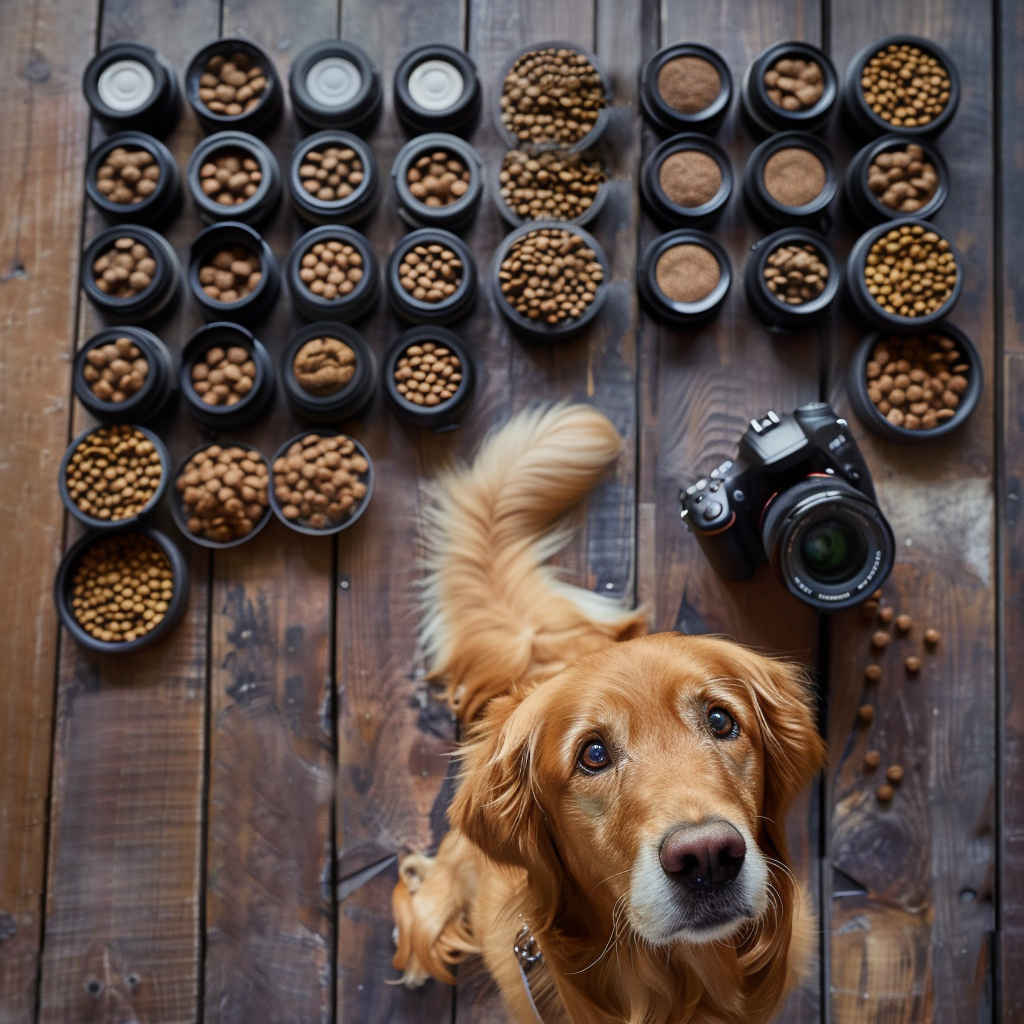
When you’re ready to snap pictures of dog food, it’s crucial to get your camera settings right. Go for a small aperture (f/2.8-f/4) to make the background fuzzy and keep the spotlight on the kibble. Try to set your ISO between 100 and 400 to avoid grainy pictures. Use a quick shutter speed to fix any shakes or wiggles and guarantee crisp images. And don’t forget a versatile tripod—it helps keep your camera steady and is a must-have if you’re snapping from the same spot over and over.
If you wanna catch every bit of crunch and crumb, a macro lens is your best bet. If not, just stick with your regular zoom lens. Using a cable release or a remote when you click the button can help keep everything tack-sharp by cutting down on jiggle. Oh, and one more thing: always shoot in RAW format. It gives you way more control when you’re editing later—you can tweak the brightness and hues without messing up the photo quality.
Lighting Techniques to Enhance the Appeal of Dog Food
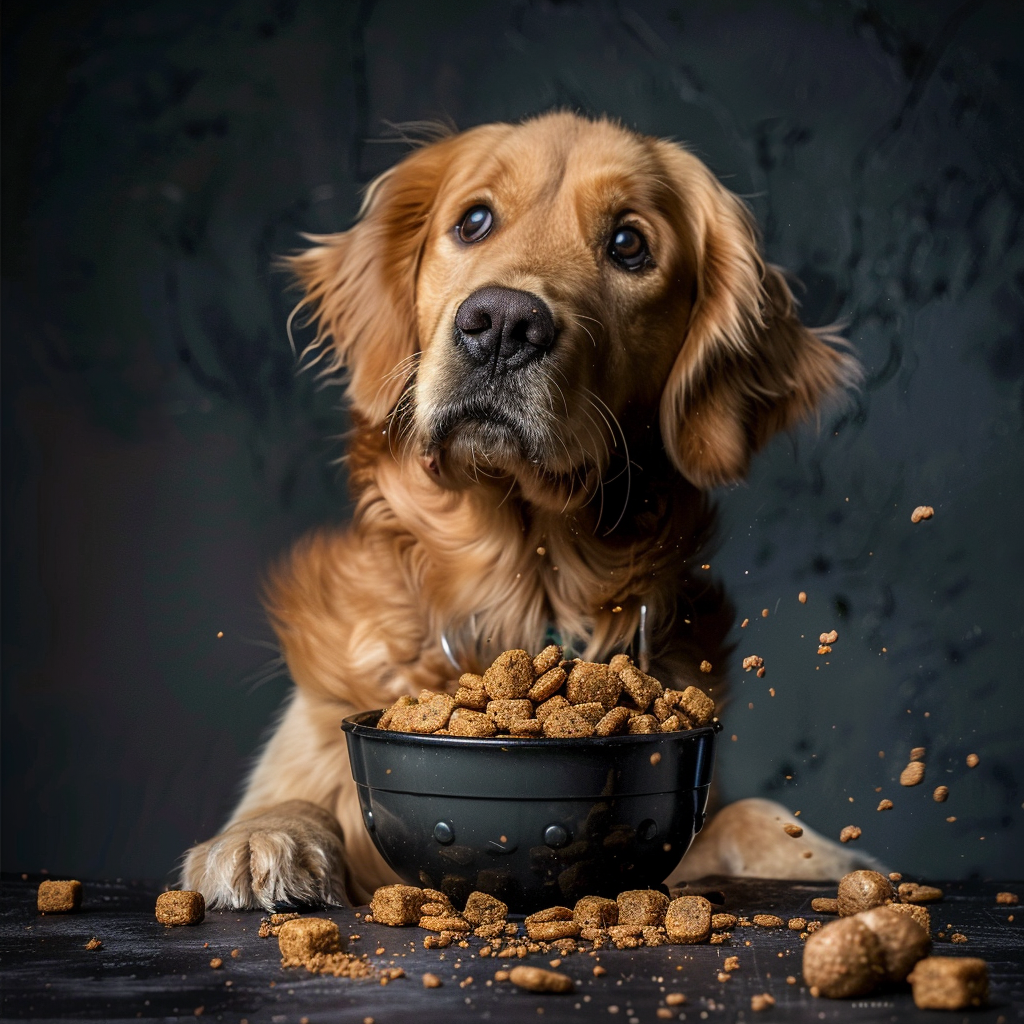
Good lighting can make dog food look more appealing by adding depth and texture while making sure there are no unattractive shadows. If you can, use natural sunlight near a window for a gentle radiance. When that’s not possible, go for artificial lights but choose ones that stay on rather than flashing ones because they make it easier to control shadows.
To look like a pro, set up two lights – a strong main light for overall brightness and a fill light to soften any deep shadows from the main light. Don’t hesitate to use reflectors such as foil or white boards to shine some extra light on the food and make every detail stand out.
Different angles of light will affect your photo dramatically. Side lighting highlights shape and texture, while backlighting can make moist food seem shiny and more tempting.
Photographing dog food isn’t just point-and-shoot; it requires focusing on technicalities like your camera settings and how you light the scene. Use the right gear and methods, steady your camera on a tripod, and illuminate the dog food carefully to make each bite glisten.
The placement in your photos matters a lot. It’s not enough to throw kibble into a bowl and click away. Use composition techniques like the rule of thirds to draw attention to key elements, perhaps a chunk of chicken or a pinch of herbs, to emphasize freshness and quality.
Visual Impact through Arrangement
Create an image that makes people ‘eat with their eyes.’ Layer the food to show off its richness and texture. You can use lines to lead the eye, like aligning the bowl towards a spoonful of wet food, creating flow in your photo.
Styling in Dog Food Photography
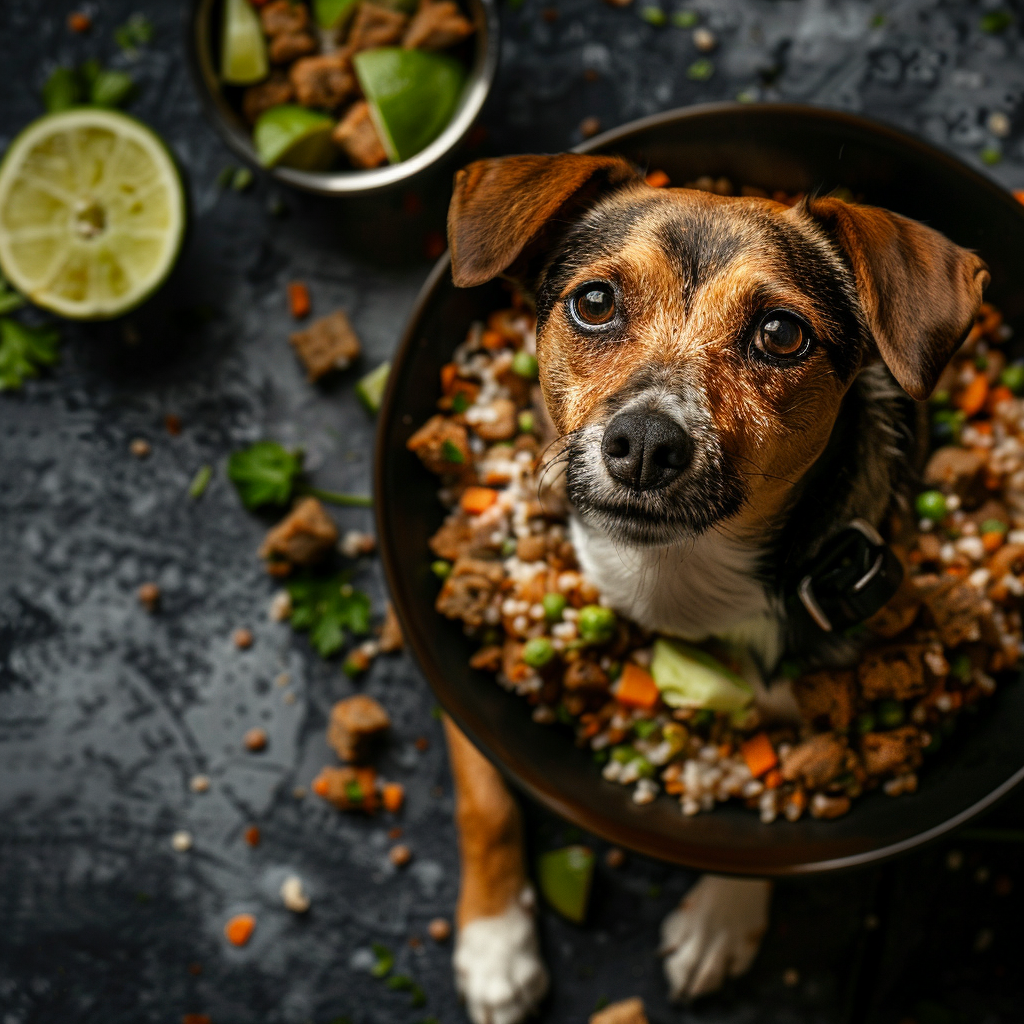
Your dog food photos must show off the brand without a single word. It’s critical to capture the right mood. Want to convey luxury? Maybe use marble or hardwood to give that fancy look. Aiming for a family feel? A cozy kitchen table might be the best choice for the shot.
Importance of Props and Backgrounds
The props you select are essential for telling a story in your images. For instance, a glossy ceramic bowl could give off an upscale vibe, while a traditional metal bowl might look more classic. Be clever with your backgrounds – some texture adds interest, but too much pattern distracts from the dog food.
Every prop and background sends a signal about the dog food’s brand. You could sprinkle ingredients seen on the packaging around the bowl or add things like frisbees or balls, hinting at the food’s energy and health perks. These tiny details finish the story of your photo and influence how pet owners feel about their choices.
The job isn’t done when you wrap up a dog food photo shoot – it’s really just starting. Post-production is crucial for crafting that final image that grabs a pet owner’s attention and sells the product. Let’s break down why post-production is so important for highlighting what’s unique about a dog food brand.
Editing Techniques to Emphasize the Product’s Features
Editors use digital tools to make sure the dog food is the star of the show. They might tweak contrast and sharpen certain areas to make the textures of the kibble or wet food pop, which is key for showing off quality. They also play with depth to keep the focus on the food.
Color Correction and Retouching for Consistency and Appeal
Color correction ensures every photo looks consistent and vibrant. Fine-tuning colors, brightness, and saturation can turn dull photos into eye-catching ones, mirroring the true colors of the food which helps people trust what they’re buying. Retouching clears away any unwanted bits, aiming for a flawless yet natural look.
In short, post-production ties together all the initial photo elements into a smooth, attractive image for customers. It fixes small errors and boosts features that connect with viewers. When done well, it practically places a bowl of tempting dog food in front of their pets.
Dog food photography is a unique part of digital marketing that targets pet nourishment. Great images don’t just show what a product looks like; they suggest its quality and appeal to dogs.
Role of Dog Food Images in Social Media and Online Advertising
Social media and online ads thrive on eye-catching visuals. Dog food photos are a mighty tool here, offering snapshots of what brands have to offer. These photos boost user engagement on platforms like Instagram or Facebook, leading to better brand recognition and sales. Appetizing images aim to strike an emotional chord with pet owners, making them imagine their dogs enjoying the food.
Evaluating the Impact of Dog Food Photographs in Digital Campaigns
To measure how effective these photos are in marketing, look at campaign stats. Things like click rates and how much people interact with your content can show how well images perform in ads. Plus, testing different images can reveal which resonate best with consumers. Checking this data helps marketers fine-tune their visual strategies.
Truthfulness and manipulation in dog food imagery
In today’s world, being honest in advertising is crucial. So, dog food pictures should be genuine. We need to avoid making the food look better than it is with digital gimmicks or fake props. People want to feed their pets the same tasty stuff they see in those shiny pics!
The impact of retouched images on consumer expectations and behavior
Editin’ pictures isn’t a no-go, but going overboard can cause issues. It sets up unrealistic hopes that let down customers if reality doesn’t match up with those enhanced images. Folks will talk if their pet’s meal isn’t what they expected – loud enough for the whole world to hear! Next time around, they might skip your brand altogether.
Diving into case studies of successful dog food photo campaigns shows us how powerful visual storytelling can be in marketing. Looking closely at these cases reveals that good imagery is more than just decoration; it’s an essential part of a narrative that speaks to pet owners’ hearts.
Strategic Imagery in Dog Food Advertising
A campaign that grabs attention usually pairs high-quality images with smart messaging. Leading brands present their product as not just food but a promoter of healthy living for pets. They use photos featuring energetic dogs while keeping the product visible.
But there’s more – campaigns also display fresh ingredients next to packaged products, quietly suggesting quality and purity, which matters to pet parents nowadays.
Psychological Impact of Effective Messaging
The success of these promotions relies heavily on the psychological effect of visual choices. Carefully designed scenes reflect more than mealtime; they capture the bond between pet and owner and the happiness that comes from feeding one’s dog well. This is no accident—each image is thoughtfully crafted to stir emotions related to health, companionship, and care.
Detailed Analysis of Campaign Effectiveness
To fully understand these successes, deep analysis is vital. Sometimes, sales go up after a campaign starts, showing that persuasive images can boost customer trust and interest directly. Owners often share how the photos helped them picture their own dogs’ joy in connection to the product.
Insights into Successful Strategy Application
The core tactics in these winning campaigns are about truthfully portraying how valuable the product is to a customer’s life – focusing on good nutrition or shared happy moments is key to gaining trust through stories told by photographs that connect with both heartstrings and market trends.
Looking at these case studies provides clear insights into how effective dog food photography not only showcases a product but captures an essence that resonates with consumers’ love for their pets and hopes for their proper diet. The perfect mix of relatable images and smart marketing narratives can raise a brand’s image well beyond being just another option for pet sustenance.
The field of pet nutrition imagery is headed towards change as new tech and creative ideas come in. Here’s what might be coming soon in this specialized area of photography.
Predictions for the Evolution of Dog Food Photography
We expect dog food photography will move towards more storytelling imagery to make emotional connections with buyers. Trends are likely shifting towards more natural settings since authenticity matters more to pet owners.
Emerging Technologies and Their Potential Impact on the Field
New technology is set to push what’s possible in dog food photography further. Smartphones with advanced cameras allow almost anyone to take pro-quality shots now. Image editing software is getting smarter and easier to use so even novices can produce top-notch work.
Beyond that, AR and VR could bring immersive experiences where buyers virtually engage with products before buying them. AI is advancing too, possibly leading to auto-editing tools that optimize photos or even create convincing images from nothing.
To wrap it up, while artistry remains fundamental, technology will definitely shape dog food photography’s future possibilities within this very important niche.

About Author
Rachel Noël is a professional photographer and videographer from the UK with over 10+ years of experience. Rachel specializes in Underwater, Tavel & Portrait photography among other areas.
